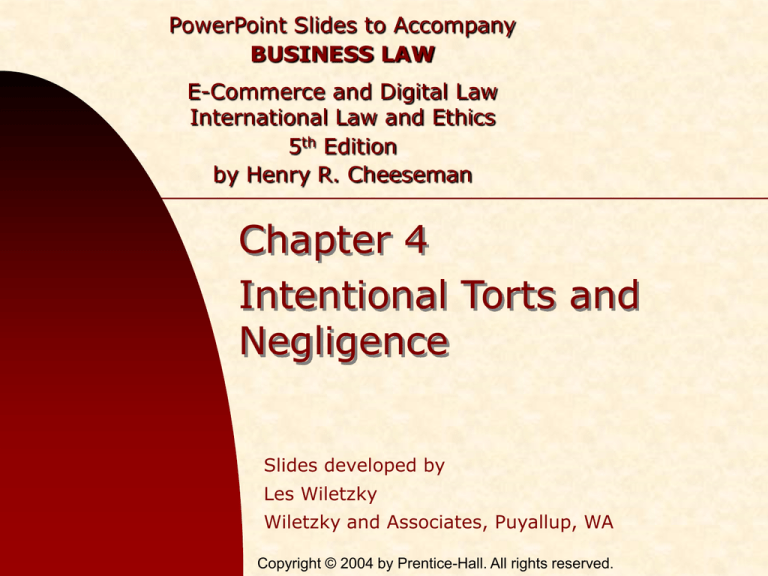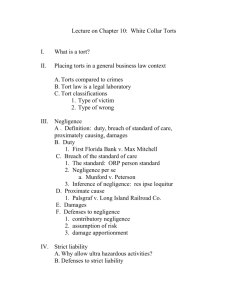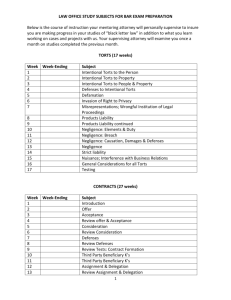
PowerPoint Slides to Accompany
BUSINESS LAW
E-Commerce and Digital Law
International Law and Ethics
5th Edition
by Henry R. Cheeseman
Chapter 4
Intentional Torts and
Negligence
Slides developed by
Les Wiletzky
Wiletzky and Associates, Puyallup, WA
Copyright © 2004 by Prentice-Hall. All rights reserved.
Introduction
Tort
is the French word for a “wrong.”
Tort
law protects a variety of injuries and
provides remedies for them.
Copyright © 2004 by Prentice-Hall. All rights reserved.
4-2
Introduction (continued)
Under
tort law, an injured party can bring
a civil lawsuit to seek compensation for
a wrong done to the party or the party’s
property.
Copyright © 2004 by Prentice-Hall. All rights reserved.
4-3
Introduction (continued)
Tort
damages are monetary damages
that are sought from the offending party.
They
are intended to compensate the
injured party for the injury suffered.
Copyright © 2004 by Prentice-Hall. All rights reserved.
4-4
Tort law imposes a duty on
persons and business agents
not to intentionally or
negligently injure others in
society.
Copyright © 2004 by Prentice-Hall. All rights reserved.
4-5
Categories of Torts
Intentional Torts
Unintentional Torts
(Negligence)
Strict Liability Torts
Copyright © 2004 by Prentice-Hall. All rights reserved.
4-6
Intentional Torts
A category of torts that requires that the
defendant possessed the intent to do the act
that caused the plaintiff’s injuries.
There are two categories of intentional torts:
Intentional torts against persons
Intentional torts against property
Copyright © 2004 by Prentice-Hall. All rights reserved.
4-7
Intentional Torts Against Persons
The law protects a person from unauthorized
touching, restraint, or other contact.
The law also protects a person’s reputation
and privacy.
Violations of these rights are actionable as
torts.
Copyright © 2004 by Prentice-Hall. All rights reserved.
4-8
Intentional Torts Against Persons (continued)
Assault
The threat of immediate harm or offensive
contact; or
Any action that arouses reasonable
apprehension of imminent harm.
Actual physical contact is unnecessary.
Copyright © 2004 by Prentice-Hall. All rights reserved.
4-9
Intentional Torts Against Persons (continued)
Battery
Unauthorized and harmful or offensive
physical contact with another person.
Actual physical contact is unnecessary.
Copyright © 2004 by Prentice-Hall. All rights reserved.
4 - 10
Intentional Torts Against Persons (continued)
False
Imprisonment
The intentional confinement or restraint of
another person without authority or
justification and without that person’s consent.
Copyright © 2004 by Prentice-Hall. All rights reserved.
4 - 11
Intentional Torts Against Persons (continued)
False
Imprisonment (continued)
Merchant Protection Statutes – allow
merchants to stop, detain, and investigate
suspected shoplifters without being held liable
for false imprisonment if:
There
are reasonable grounds for the suspicion,
Suspects are detained for only a reasonable time, and
Investigations are conducted in a reasonable manner.
Copyright © 2004 by Prentice-Hall. All rights reserved.
4 - 12
Intentional Torts Against Persons (continued)
Defamation
of Character
False statement(s) made by one person
about another. The plaintiff must prove that:
The defendant made an an untrue statement
of fact about the plaintiff; and
The statement was intentionally or
accidentally published to a third party.
Copyright © 2004 by Prentice-Hall. All rights reserved.
4 - 13
Intentional Torts Against Persons (continued)
Defamation
of Character (continued)
Slander – oral defamation of character.
Libel – a false statement that appears in a
letter, newspaper, magazine, book, photo,
video, etc.
Copyright © 2004 by Prentice-Hall. All rights reserved.
4 - 14
Landmark Law
In New York Times v. Sullivan, the U.S.
Supreme Court held that public officials
cannot recover for defamation unless they
can prove that the defendant acted with
actual malice.
Copyright © 2004 by Prentice-Hall. All rights reserved.
4 - 15
Intentional Torts Against Persons (continued)
Misappropriation of the Right to Publicity
An attempt by another person to appropriate
a living person’s name or identity for
commercial purposes.
Also known as the tort of appropriation.
Copyright © 2004 by Prentice-Hall. All rights reserved.
4 - 16
Intentional Torts Against Persons (continued)
Invasion
of the Right to Privacy
A tort that constitutes the violation of a
person’s right to live his or her life without
being subjected to unwanted and undesired
publicity.
Copyright © 2004 by Prentice-Hall. All rights reserved.
4 - 17
Intentional Torts Against Persons (continued)
Intentional Infliction of Emotional Distress
A tort that says a person whose extreme and
outrageous conduct intentionally or recklessly
causes severe emotional distress to another
person is liable for that emotional distress.
Also known as the tort of outrage.
Copyright © 2004 by Prentice-Hall. All rights reserved.
4 - 18
Intentional Torts Against Property
There are two general categories of property:
Real Property – consists of land and
anything permanently attached to that land.
Personal Property – consist of things that
are movable.
Automobiles
Books
Clothes
Pets
Copyright © 2004 by Prentice-Hall. All rights reserved.
4 - 19
Intentional Torts Against Property (continued)
Trespass
to Land
A tort that interferes with an owner’s right to
exclusive possession of land.
Copyright © 2004 by Prentice-Hall. All rights reserved.
4 - 20
Intentional Torts Against Property (continued)
Trespass
to Personal Property
A tort that occurs whenever one person
injures another person’s personal property; or
Interferes with that person’s enjoyment of his
or her personal property.
Copyright © 2004 by Prentice-Hall. All rights reserved.
4 - 21
Intentional Torts Against Property (continued)
Conversion
of Personal Property
A tort that deprives a true owner of the use
and enjoyment of his or her personal property
by:
Taking over such property; and
Exercising ownership rights over it.
Copyright © 2004 by Prentice-Hall. All rights reserved.
4 - 22
Unintentional Torts (Negligence)
Unintentional
Tort
A doctrine that says a person is liable for
harm that is the foreseeable consequence of
his or her actions.
Copyright © 2004 by Prentice-Hall. All rights reserved.
4 - 23
Unintentional Torts (Negligence)
(continued)
Negligence
The omission to do something which a
reasonable person would do; or
Doing something which a prudent and
reasonable man would not do.
Copyright © 2004 by Prentice-Hall. All rights reserved.
4 - 24
Unintentional Torts (Negligence)
(continued)
To be successful in a negligence lawsuit, the
plaintiff must prove that:
1. The defendant owed a duty of care to the
plaintiff
2. The defendant breached the duty of care
3. The plaintiff suffered injury
4. The defendant’s negligent act caused the
plaintiff’s injury
Copyright © 2004 by Prentice-Hall. All rights reserved.
4 - 25
Unintentional Torts (Negligence)
(continued)
Duty of Care – the obligation we all each
other not to cause any unreasonable harm or
risk of harm.
The courts apply a reasonable person
standard.
Defendants with a particular expertise or
competence are measured against a
reasonable professional standard.
Copyright © 2004 by Prentice-Hall. All rights reserved.
4 - 26
Unintentional Torts (Negligence)
(continued)
Breach of Duty – a failure to exercise care
or to act as a reasonable person would act.
Injury to Plaintiff – the plaintiff must suffer
personal injury or damage to his or her
property to recover monetary damages for
the defendant’s negligence.
Effect on the plaintiff’s life or profession.
Copyright © 2004 by Prentice-Hall. All rights reserved.
4 - 27
Unintentional Torts (Negligence)
(continued)
Causation – a person who commits a
negligent act is not liable unless his or her
act was the cause of the plaintiff’s injuries.
Causation in Fact (actual cause)
Proximate Cause (legal cause)
Copyright © 2004 by Prentice-Hall. All rights reserved.
4 - 28
Unintentional Torts (Negligence)
(continued)
Causation
in Fact (actual cause)
The actual cause of negligence.
A person who commits a negligent act is not
liable unless causation in fact can be proven.
Copyright © 2004 by Prentice-Hall. All rights reserved.
4 - 29
Unintentional Torts (Negligence)
(continued)
Proximate Cause (legal cause)
Under the law, a negligent party is not
necessarily liable for all damages set in
motion by his or her negligent act.
The law establishes a point along the damage
chain after which the negligent party is no
longer legally responsible for the
consequences of his or her actions.
Copyright © 2004 by Prentice-Hall. All rights reserved.
4 - 30
Landmark Law
The doctrine of proximate cause was defined
in the Palsgraf v. Long Island Railroad
Company case.
Copyright © 2004 by Prentice-Hall. All rights reserved.
4 - 31
Unintentional Torts (Negligence)
(continued)
Negligent Infliction of Emotional Distress
A tort that permits a person to recover for
emotional distress caused by the defendant’s
negligent conduct.
Professional Malpractice
The liability of a professional who breaches
his or her duty of ordinary care.
Copyright © 2004 by Prentice-Hall. All rights reserved.
4 - 32
Special Negligence Doctrines
Negligence Per Se
Res Ipsa Loquitur
Good Samaritan Laws
Dram Shop Acts
Guest Statutes
Fireman’s Rule
“Danger Invites
Rescue” Doctrine
Social Host Liability
Liability of
Landowners
Liability of Common
Carriers and
Innkeepers
Copyright © 2004 by Prentice-Hall. All rights reserved.
4 - 33
Superseding or
Assumption of
Intervening
the Risk
Event
DEFENSES
AGAINST
NEGLIGENCE
Contributory
Comparative
Negligence
Negligence
Copyright © 2004 by Prentice-Hall. All rights reserved.
4 - 34
Business Torts
Entering certain businesses and professions
without a license
Unfair competition
Predatory practices
Palming off
Copyright © 2004 by Prentice-Hall. All rights reserved.
4 - 35
Business Torts (continued)
Disparagement
Product disparagement
Trade libel
Slander of title
False advertising
Intentional misrepresentation (fraud)
Copyright © 2004 by Prentice-Hall. All rights reserved.
4 - 36
Business Torts (continued)
The elements required to find fraud are:
1. The wrongdoer made a false representation
of material fact.
2. The wrongdoer had knowledge that the
representation was false and intended to
deceive the innocent party.
3. The innocent party justifiably relied on the
misrepresentation.
4. The innocent party was injured.
Copyright © 2004 by Prentice-Hall. All rights reserved.
4 - 37
Business Torts (continued)
Intentional interference with contractual
relations
Breach of the implied covenant of good faith
and fair dealing
Copyright © 2004 by Prentice-Hall. All rights reserved.
4 - 38
Business Torts (continued)
Punitive damages
Are not recoverable for breach of contract
Recoverable for certain tortious conduct
Fraud
Intentional conduct
Other egregious conduct
Copyright © 2004 by Prentice-Hall. All rights reserved.
4 - 39
Strict Liability
Strict liability is liability without fault.
A participant in a covered activity will be held
liable for any injuries caused by the activity
even if he or she was not negligent.
Copyright © 2004 by Prentice-Hall. All rights reserved.
4 - 40
Strict Liability (continued)
This doctrine holds that:
1. There are certain activities that can place
the public at risk of injury even if reasonable
care is taken; and
2. The public should have some means of
compensation if such injury occurs.
Copyright © 2004 by Prentice-Hall. All rights reserved.
4 - 41





